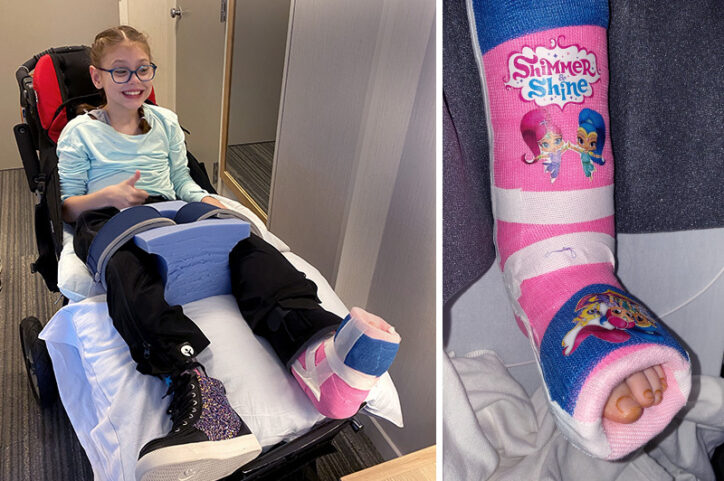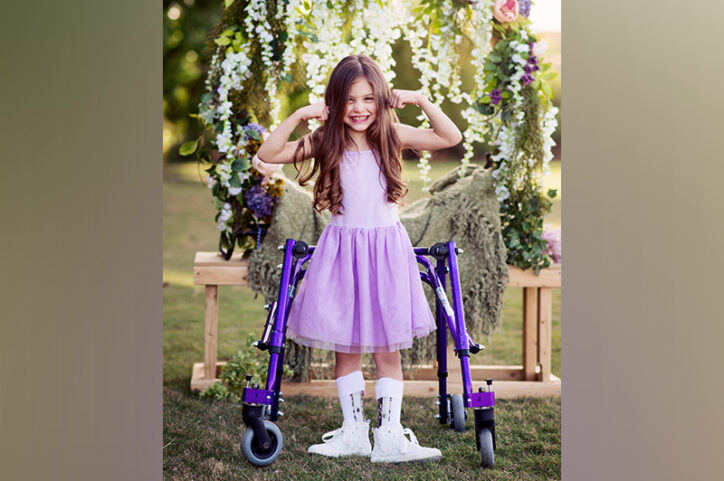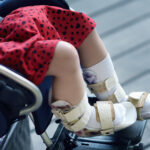A cerebral palsy journey lands in Boston: Ashlyn’s hip surgery

Eleven-year-old Ashlyn’s parents describe her as spicy, strong willed, and determined. Those qualities have served her well through a medical journey that started soon after she was born with cerebral palsy (CP). Ashlyn has had multiple operations to manage the symptoms of CP, but when it came to the question of hip surgery, her parents struggled to get a clear answer.
About 35 percent of children with CP experience hip displacement. The condition, when the ball at the top of the thighbone slips outside of the hip socket, leads to chronic pain, impaired function, and decreased quality of life. Hip surgery can reduce these risks by reshaping and repositioning the bones around the joint, but it’s a major operation. Ashlyn’s parents, Carrie and Nathan Ford, didn’t want to put their daughter through hip surgery without knowing for sure that she needed it.
“We went back and forth with Ashlyn’s doctors for years,” says Carrie. Starting in Arizona, where the family lives, and then later in the Midwest, “most of the doctors would take a single x-ray, some would watch her walk, and tell us she did or didn’t need surgery,” says Carrie.
Looking for someone who would take a more comprehensive approach to their daughter’s prognosis, the Fords researched best children’s hospitals and found Boston Children’s Hospital. Soon, they were meeting with Dr. Benjamin Shore, director of the Cerebral Palsy and Spasticity Center.
An in-depth look at Ashlyn’s complex hips
When Dr. Shore met Ashlyn in person and heard about her symptoms, he suspected her hips were more complex than an x-ray could detect. He ordered a computed tomography (CT) scan and let the Fords know he would be talking about Ashlyn’s case with other specialists in Boston Children’s Orthopedic Center.
Two weeks later, Dr. Shore broke the news to the family that Ashlyn would need hip surgery. Having reviewed her CT scans, he said her hips would require complex surgery and would need to be operated on separately. Given the complexity of her hips, he was amazed she was able to walk at all.
It was the first time a doctor said they wanted to bring in someone else to give Ashlyn the best possible chance of a good outcome.”
Dr. Shore had asked his colleague, Dr. Young-Jo Kim, director of the Child and Young Adult Hip Preservation Program, to collaborate with him on Ashlyn’s treatment. If the Fords chose to schedule the surgery at Boston Children’s, Dr. Kim would focus on changing the orientation of her hip sockets. Dr. Shore would reposition the bones in Ashlyn’s legs to improve her gait and realign the balls at the tops of her thighbones to fit securely in the sockets.
“It was the first time a doctor said they wanted to bring in someone else to give Ashlyn the best possible chance of a good outcome,” says Nathan. “We found that very reassuring.”
Shimmer and Shine to the rescue
The Fords now had an answer to whether Ashlyn needed hip surgery: She would undergo surgery on her right hip and lower leg. Four months later, she’d have a similar operation on her left side. They felt confident in the surgical team at Boston Children’s. But what about Ashlyn’s physical and emotional well-being? In addition to CP, she has anxiety, autism, and epilepsy and is on a special diet to control seizures.

“Dr. Shore coordinated all of her care,” says Carrie. This included her care at Boston Children’s as well as communicating with her care team in Arizona to ensure her follow-up care would be seamless when she returned home.
He also got to know Ashlyn as a person. The two connected over her love of books and favorite TV show, Shimmer and Shine. “Ashlyn always lights up when Dr. Shore walks in the room,” says Carrie.
To ease her anxiety at the pre-operative appointment the day before surgery, Child Life Services brought Ashlyn and her parents to a private area, away from the busy waiting area. There they found Shimmer and Shine coloring pages and magic markers for Ashlyn. The next day, when Ashlyn woke up from surgery, she found images of her favorite characters on her cast.
Ashlyn’s recovery and the road ahead
Carrie and Nathan have grown used to uncertainty. For years, they lived with uncertainty over whether Ashlyn needed hip surgery. Now the questions have shifted to her future mobility.
When Dr. Shore told Carrie and Nathan that Ashlyn needed hip surgery, he let them know that her recovery could take up to two years. He couldn’t promise how much mobility she’d regain, but he gave them an important assurance. “He told us, ‘If you choose to have the surgery here, I promise you we will do our best to give her the most mobility possible,’” says Carrie.

So far, Ashlyn has surprised everyone. After the surgery in November, she was up and walking with a walker within three months. Two weeks after her second surgery, she already wanted to stand on her own.
Reflecting on their experience at Boston Children’s, Nathan says, “We’ve been doing this for a long time; we’ve been all over the country for Ashlyn’s care. Hands down, this is by far the best medical experience we’ve had.”
Learn more about the Cerebral Palsy and Spasticity Center and Child and Young Adult Hip Preservation Program.
Related Posts :
-

Research offers guidance on genetic testing for cerebral palsy
A recent meta-analysis confirms what a small study at Boston Children’s found last year: About 1 in 4 children with cerebral ...
-

'Anything is possible': The sky’s the limit for teen with cerebral palsy
Jack Goldberg is on a mission. “I want other kids to see that if you work hard and put your ...
-

Rethinking the origins of cerebral palsy
Cerebral palsy (CP) has widely been viewed as the result of perinatal oxygen deprivation or other birth-related factors like prematurity. ...
-

What it’s like to have SDR surgery: Scarlet’s story
Scarlet is 9 years old. When she was 7, she underwent selective dorsal rhizotomy (SDR), a procedure in which a surgeon cuts ...





